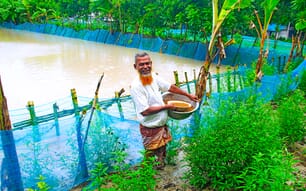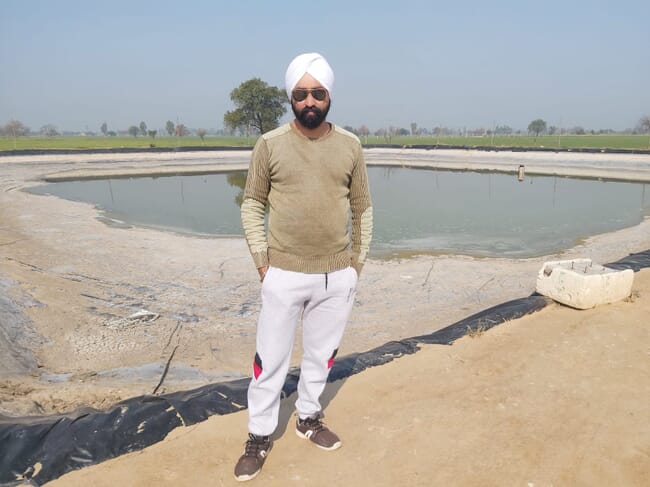
Singh established an inland shrimp farm in 2017
Despite his urban and educated background, the 39-year-old was inspired to move to the countryside from Chandigarh by the prospects of working independently, the relatively low startup costs – combined with government subsidies – and his love of seafood.
“I think that seafood is the future for providing healthy food to the growing population of India. I am myself very fond of shrimp – it’s my favourite food,” he explains.
While the majority of India’s shrimp farming sector takes place in the country’s southern coastal states, Singh saw the opportunity for establishing a farm in his native north India and – remarkably – chose a site in the Punjabi region of Mansa, 1,500 km from the sea.
“We don’t have access to the coast, but we do have access to saline water: by putting in a 110 foot borehole we can reach underground water that’s 10 ppt, which is perfect for growing shrimp, And because it comes from underground it’s disease-free,” he explains.
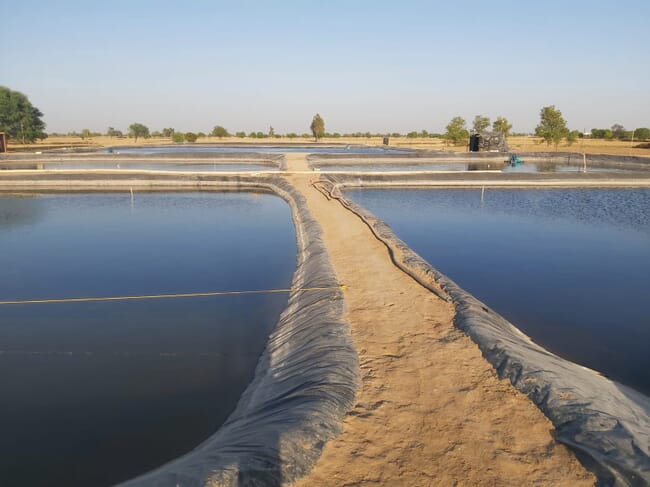
Since Singh sources his saline water from a 110 foot borehole, his shrimp are disease-free
Having a hugely reduced threat of pathogens is a great advantage for farmers in the Punjab, which is one reason the state – and its northern neighbours – are in the midst of a mini shrimp boom.
“Punjab, Rajasthan and Haryana might only account for 2 percent of India’s shrimp production at the moment, but the production of the three states is growing by 30 percent a year,” Singh explains.
The northern location also potentially gives them access to access to a different market, but being so far from the country’s shrimp farming epicentre has its drawbacks too.
“There are no feed mills here, so we have to source our feed from the south, which makes it around 10 percent more expensive compared to what southern farmers are paying,” says Singh.
But the comparatively low risk of disease outbreaks means that he’s willing to grow his shrimp for longer in order to fetch a better price.
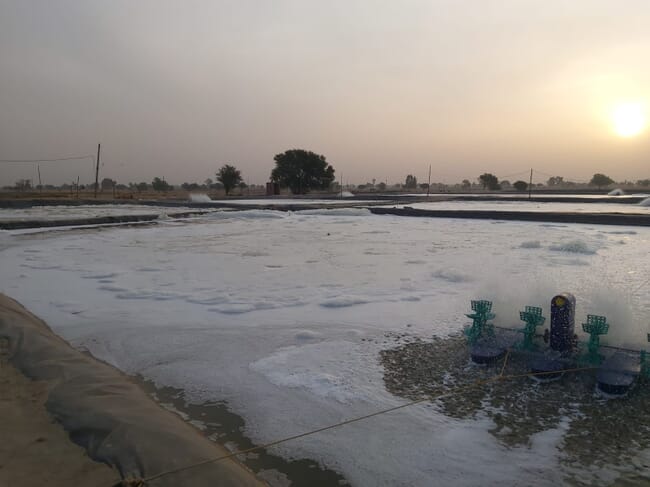
The lower disease risk means the Singh can grow his shrimp to larger sizes, letting him fetch a better market price and cover his operating costs
“We can help to cover our higher operating costs by selling larger sized shrimp [30 per kg], and we have a low density, large size production model,” he says.
Being located so far north of the Equator, with a growing season that lasts from March to October, also limits him to producing a single crop of shrimp per year, while most southern farmers can manage two crops.
“This increases the risk for us – if one crop fails we need to wait another year to be able to hope to make any losses back,” notes Singh.
However – given his business background – Singh is looking into ways to making the most of those eight months when he’s not actually growing shrimp, as there’s more than enough time for him to disinfect the empty ponds and make the necessary repairs to his infrastructure between cycles.
“I’m investigating setting up a processing facility on the farm, with the aim of selling frozen shrimp for the domestic market. India currently exports 95 percent of its farmed vannamei shrimp but the domestic market could be huge. We have a population second only to China and demand for seafood is growing, but we must ensure that we can sell them good quality shrimp,” he reflects.
If his pilot project is successful, he hopes he can expand the operation so it can act as a processing hub for all the shrimp farmers in the surrounding area.
“It will also mean that I can spend the off-season selling the shrimp,” he reflects.
Singh sees huge opportunities for other urban entrepreneurs to follow in his footsteps and start shrimp farming in rural regions of northern India. But he does concede that it took a bit of work to establish the farm and convince the local population that his arrival could have broader benefits.
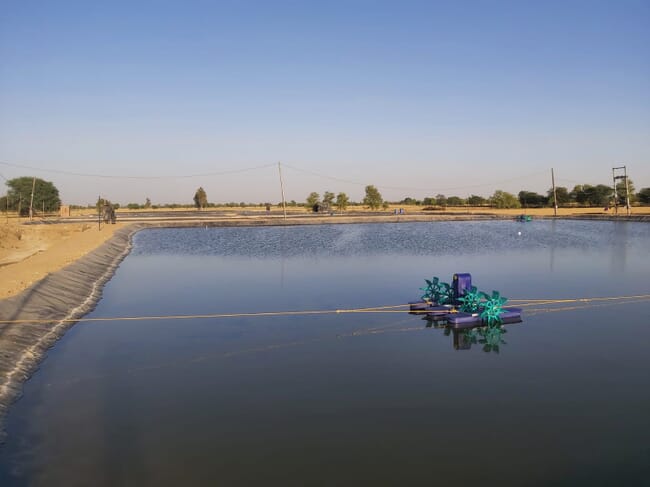
Singh’s first year in farming involved excavating two ponds on leased land and he’s since expanded to seven ponds
“When I first arrived many local people were suspicious of what I wanted. To he honest there is a culture difference but you have to understand their way of living. They can’t change for you, you have to change for them. It’s taken a while to break the ice, but the community now sees the benefits – I employ local people and buy my supplies from local shopkeepers,” he explains.
Meanwhile, the end of each cycle the wastewater is channelled off to irrigate neighbouring farmers’ wheat and cotton fields.
According to Singh, despite the salty nature of the water, it actually boosts farmers’ yields.
“The farmers were already using saline water for irrigating their crops and the water from the shrimp farms contains more nutrients,” he explains.
Singh’s first year in farming involved excavating two ponds on leased land and he’s since expanded to seven ponds, spread over seven acres, from which he’s able to produce around 30 tonnes of shrimp a year.
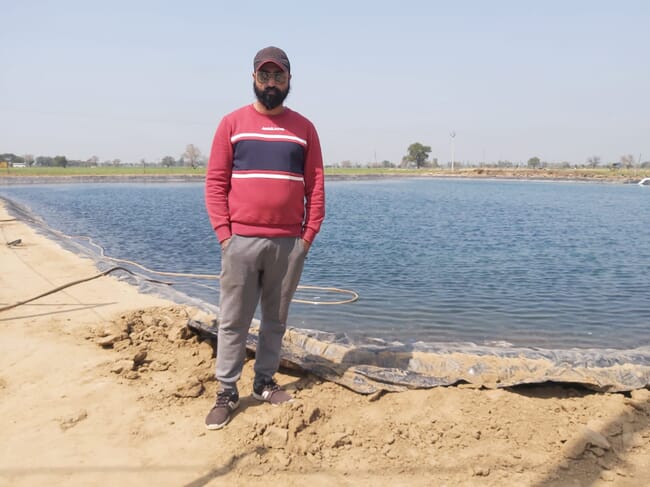
Singh is able to produce 30 tonnes of shrimp each year
According to Singh it costs about 10 lakh (1 million) rupees per acre to establish a farm – ie excavate the ponds and buy the necessary equipment, such as aerators and installing boreholes. However, this figure is halved by the presence of a 50 percent government subsidy.
This allows new farmers to pay off their startup costs and start turning a profit by the second cycle, according to Singh. It has also enabled him to expand the farm without external investment and he now farms seven ponds over seven hectares and employs ten people, in a semi-intensive production system.
Technological limitations
Despite Singh’s forward-thinking nature many of the day-to-day tasks are done without the aid of technology – there’s no internet connectivity on the farm, the shrimp are hand-fed, and someone needs to be on call throughout the night to fire up the backup generator in case there’s a power cut.
Nonetheless Singh is confident that bringing a new outlook and the necessary skills to northern India’s shrimp sector can lead to great things.
“I’ve experienced the corporate world, the rural world and the business world. I’m planning to put all this experience together – for acquiring raw materials, running factories and for selling the shrimp you need all three skills. If you get all three right then the future is bright,” he concludes.


